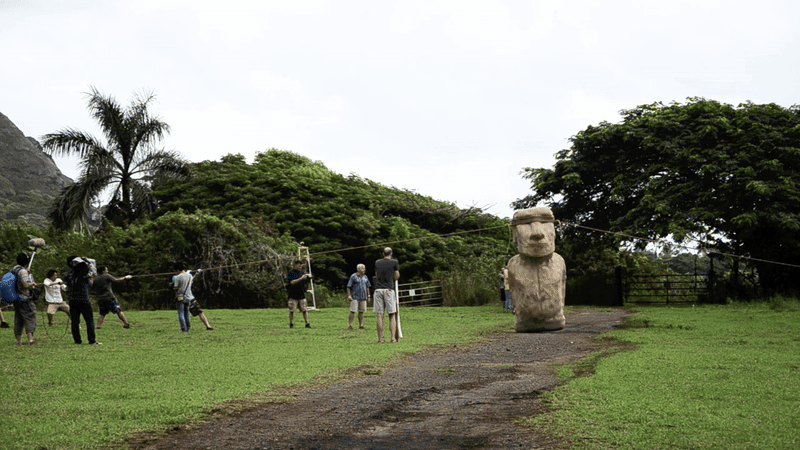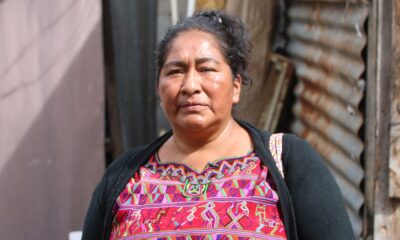Science
Easter Island Moai Statues Could Have “Walked” with Minimal Effort

Recent research suggests that the iconic moai statues of Easter Island could have been moved using a technique that allowed them to “walk” across the landscape with the assistance of just a small group of people, ropes, and the principles of pendulum dynamics. This finding challenges long-held beliefs about how the Indigenous Rapa Nui people transported these massive stone figures, which can weigh several tons. The study, published in the November 2025 issue of the Journal of Archaeological Science, offers new insights into the transportation methods used centuries ago.
Researchers, led by Carl Lipo, a professor of anthropology at Binghamton University, discovered that the moai statues were designed with specific physical characteristics that facilitated their movement. By examining incomplete statues discarded shortly after quarrying, the team noted that these moai had a low center of mass and a forward lean, which would have aided in their transport.
Through virtual reconstructions, the researchers demonstrated that with the use of three ropes and a team of between five and 60 people, the moai could take steps averaging 35 inches (89 centimeters) long. This method challenges the traditional view that moving the moai required a large workforce and extensive resources. Lipo stated, “What we found is the fact that statues were moved with very small numbers of people in an amazingly ingenious way.”
Innovative Techniques and Experimental Evidence
The Rapa Nui community, which settled on Easter Island approximately 1,000 years ago, is known for creating nearly 1,000 moai, which depict human heads and torsos ranging from 3.7 feet (1.1 meters) to 32.6 feet (9.8 meters) tall. These statues were typically transported more than 6.2 miles (10 kilometers) from the Rano Raraku quarry to their ceremonial locations. The question of how these massive figures were moved has been a point of contention among anthropologists.
In a televised experiment conducted in 2012, Lipo and his team demonstrated the feasibility of the “walking” hypothesis by moving a scaled replica weighing 4.8 tons (4.4 metric tons) over a distance of 328 feet (100 meters) using a team of 18 people. Lipo acknowledged that the testing of the physics involved should have been done prior to the experiment but emphasized the aim was to determine the minimum number of people required for movement.
To further validate their findings, Lipo and co-author Terry Hunt, a professor of anthropology at the University of Arizona, created 3D models of 62 moai located along ancient roads, referred to as “road moai.” These models indicated that the statues had a forward lean of between 6 and 15 degrees, allowing them to sway and “walk” when pulled.
Implications and Perspectives
The research presents compelling evidence against the notion that transporting the moai necessitated vast resources and manpower. According to the authors, the method of moving the statues was not only efficient but also showcased the ingenuity of the Rapa Nui people. The study found that the moai could travel an average of 1,000 feet (310 meters) per hour, and an average-size moai would require approximately 11,000 steps for a journey of 6.2 miles (10 kilometers).
While the findings have generated significant interest, some experts urge caution. Sue Hamilton, an archaeologist and professor of prehistory at University College London, acknowledged that the study contributes valuable insights but also noted that the data could support multiple interpretations. Hamilton pointed out that the “road moai” might have been constructed for different ceremonial purposes or by individuals with varying skills, thus complicating the narrative.
In conclusion, while the study proposes a plausible mechanism for the movement of the moai, it does not definitively prove that this method was exclusively used. Lipo and Hunt argue that critics have yet to present viable alternatives that reconcile the full spectrum of evidence available. As discussions continue, this research adds a fascinating layer to the understanding of the cultural and engineering capabilities of the Rapa Nui people.
-

 World5 days ago
World5 days agoExposing the Reality Behind Guatemala’s Garment Industry
-

 Politics5 days ago
Politics5 days agoLB Pharmaceuticals Quiet Period Ends October 21, Analysts Weigh In
-

 Business5 days ago
Business5 days agoRoyal Bank of Canada Upgrades Ovintiv to Outperform Rating
-

 Sports5 days ago
Sports5 days agoSaquon Barkley Reflects on James Franklin’s Dismissal from Penn State
-

 World5 days ago
World5 days agoHamas to Return Remains of Additional Hostage on Friday
-

 Health5 days ago
Health5 days agoFDA Announces First Nine Recipients of National Priority Vouchers
-

 Science5 days ago
Science5 days agoMIT Develops 3D Brain Models from Patient Cells for Custom Therapies
-

 Entertainment5 days ago
Entertainment5 days agoOlivia Nuzzi’s Memoir Set to Uncover RFK Jr.’s Controversial Texts
-

 Lifestyle3 days ago
Lifestyle3 days agoHistorian Seeks Help to Uncover Cherry Street’s Past
-

 Science3 days ago
Science3 days agoYale School of the Environment Launches Accelerated Master’s Programs
-

 Entertainment5 days ago
Entertainment5 days agoSylvester Stallone’s ‘Alarum’ Surges in Streaming Despite Poor Reviews
-

 Lifestyle5 days ago
Lifestyle5 days agoSouth Los Angeles Intersection Renamed to Honor Activist Danny Bakewell Sr.









